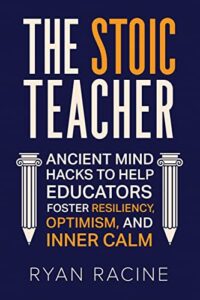Making Stoicism a Daily Classroom Practice
The Stoic Teacher: Ancient Mind Hacks to Help Educators Foster Resiliency, Optimism, and Inner Calm
By Ryan Racine
(Alphabet Publishing, 2022 – Learn more)
Reviewed by Greg Feezell

Roman baths, according to Epictetus, were unruly places, rife with loud arguments, cursing, fighting, and theft. As he saw it, this was the nature of a Roman bath – it was just the way things were and there was no sense getting upset about it. He went to the baths mentally prepared, knowing what to expect and able to handle it.
Isn’t that good advice for teachers as well? The school has faculty meetings every Tuesday afternoon? Sure, that’s how it is. No need being upset about it. Some of our students are acting out because of troubles at home? It happens. We have a better chance to help if we stay calm.
 Stoic philosophy is based on a simple idea: there are things that we have influence over, and there are things that are entirely outside our control. It is logical to focus our energies on the things that we have influence over. Stoic thinking values the virtues of wisdom, justice, courage, and moderation.
Stoic philosophy is based on a simple idea: there are things that we have influence over, and there are things that are entirely outside our control. It is logical to focus our energies on the things that we have influence over. Stoic thinking values the virtues of wisdom, justice, courage, and moderation.
This philosophy is having a resurgence as modern Stoics create content including podcasts, blogs, YouTube videos, and books. One such book is The Stoic Teacher: Ancient Mind Hacks to Help Educators Foster Resiliency, Optimism, and Inner Calm by Ryan Racine.
The Stoic Teacher is full of worthy advice. The author journals in the morning and then again at the end of the teaching day. No doubt if I found time to follow that regimen it would lead to greater insights and improve my teaching.
Other suggestions are equally unassailable. We could all benefit from having mentors, from keeping things in perspective and from practicing self-care. Each chapter ends with a series of questions that might be used for self-reflection or for facilitating group discussion.
A quick, introductory read
At slightly over a hundred pages, The Stoic Teacher can be read quickly. (As a Stoic writer, Racine more closely resembles the pithy Epictetus than the loquacious Seneca.) Some busy readers might appreciate this approach, but I hoped for a more in-depth treatment, especially regarding the practical ways that Stoicism can enrich the teaching life.
Racine incorporates a lot of outside material, including quotations from ancient Stoics and modern writers, as well as testimonials from other teachers about the practical benefits of Stoicism. This is all good, but I found the sections describing his own experiences with Stoicism underdeveloped.
The Stoic Teacher appears to be a book without a clear readership. If you are already acquainted with Stoic teaching, whether through the ancient texts such as the Meditations by Marcus Aurelius or YouTube channels featuring modern Stoics, it’s unlikely that you are going to find much in The Stoic Teacher that you are unfamiliar with, although you may appreciate being refreshed.
On the other hand, if you’re new to Stoicism, while Racine’s book might whet your appetite there are much better places to jump in. I recommend starting at the source. You might try The Enchiridion, a handbook of Stoic maxims and guidance from Epictetus.
Greg Feezell has taught elementary and middle school in the United States and Japan. He is graduate of Cal Poly San Luis Obispo and CSU Dominguez Hills. As a teacher, he strives to engage his students in reading, writing, and discussion.































